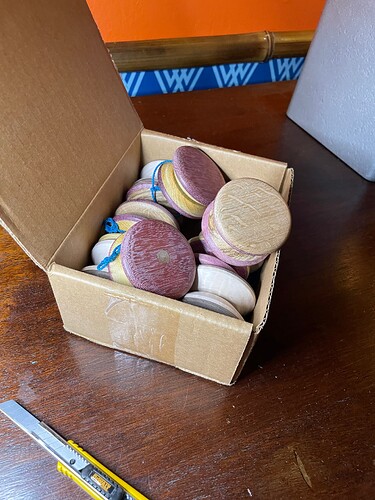I got a TAW/TAW made from oak coming in the mail soon and I want to protect it, what should I do? Mineral oil? Boiled linseed oil? I dunno if I want an actual “finished” feel because I love the raw feel of the wood, but I also don’t want it to get dirty over the years.
@Glenacius_K is more of a wood working expert on this topic. In my experience however, just play and the natural oils from your hands works rather good as well, sometimes I just rubber my hands all over them.
Hi everyone!
I have not manufactured it myself, but looking on a second-hand purchase and sale page in my country, I have found this yoyo for sale! It says that it is inspired by the shape of a button and that it was made by hand in 2010: )
It seemed curious to me, (artisan yo-yos are not usually sold).
I have also found a black Dark Magic 2 yoyojam, new in a box for about € 20 and I could not resist buying it, next week it will be in my hands;)
I leave you the photos that appeared in the ad.
If people have been using it for millennia, then it must be fine. I doubt people would have been sitting in their houses with the furniture stinking all about them.
I just read that it polymerizes (dries) so that’s good. It’s only a problem if they don’t as far as I know.
How did you snap your Harbinger axle? Was it one of the old models with a 1/4" walnut axle?
I generally rub my personal greeze in every raw wood throw I receive. Don’t buy one from me, ![]() . The exception is the spectrapop Knack Glen made. Has some edges I didn’t want to scratch me.
. The exception is the spectrapop Knack Glen made. Has some edges I didn’t want to scratch me.
Man greeze.
Sounds like a needlessly gendered hair care product ![]()
Sounds gross but I’ll try it ![]()
With the TAW-TAW, just watch the locking nut cut. Owie.
Oh heck yeah
Sweet#
This is my long term coating test. From top polished with old silicone impregnated gun cloth(don’t ask me why but I was just curious), 100% bee’s wax(what you polish a briar smoking pipe with), 100% Man-Grease, and laquer. So far they all look great, feel and play great. Nothing to complain about yet. We’ll see what holds up best.
How did you apply/spread the bees wax?
It’s rock hard stuff. But I rubbed it really good just with the hard wax, then I heated it up with a lighter and dripped a little on it and spread it with the now slightly softer wax. Then I carefully heated a small spot with the lighter and rubbed it the rest of the way with a rag. It actually looks good but has a very slight waxy feel but that’s wearing off.
It goes rancid due to oxidation from being in contact with the open air and light. It does take time but it’ll eventually happen to most food grade oils that contain unsaturated and / or polyunsaturated fats (vegetable, corn, peanut, grapeseed, sesame, macadamia nut, canola, coconut, olive oil, etc.). Heat can also accelerate the oxidation / spoilage of the oils so if it’s particularly warm they’ll oxidize much faster. Aside from smelling funky, it can also discolor the wood it’s applied to and it can also make the wood feel tacky and sticky.
That doesn’t mean there aren’t food safe oils that are good for wood though! You just have to use specific ones that harden or polymerize naturally. Since we’re not eating off of yoyos, there are tons of safe options. We can use pretty much any type of finish on yoyos, but if you’re concerned about food safety or want to limit chemical contact, then natural oils are a good way to go.
Here are a few
- Tung Oil pure form is best
- Raw Linseed (flax) - Be careful, some boiled linseed oils will have have yucky chemicals to accelerate drying. Make sure it’s fully cured before handling it and if possible, try to find raw linseed if you’re worried about being food safe.
- Beeswax - It’s often mixed with other oils like mineral oil so it can be applied like a paste.
- Mineral oil / butcher block oil - Mineral oil is petroleum based but is generally considered food safe in most cases.
- Walnut - Becareful though, walnut oil can create a tackiness if it’s not applied and wiped off correctly.
- Teak (blend of tung and linseed)
- Danish oil - (technically not natural but is used often) - It’s generally tung or linseed mixed with a varnish. (not food safe)
- Fractionated Coconut oil - The fatty acids have been removed so it won’t spoil like regular coconut oil would.
I found a good combination is several coats of Danish oil, allowed to dry naturally over a couple of days then sealed with five coats of a water-based quick-dry diamond finish varnish (matte, satin or gloss). Each coat is very lightly sanded with 400grit paper.
The oil teases out the beauty in the wood and the varnish seals it and gives a really hard finish that isn’t sticky.
I wanted a ‘coffee n cream’ appearance for my plywood Apollo tribute and this combination provided exactly that.










